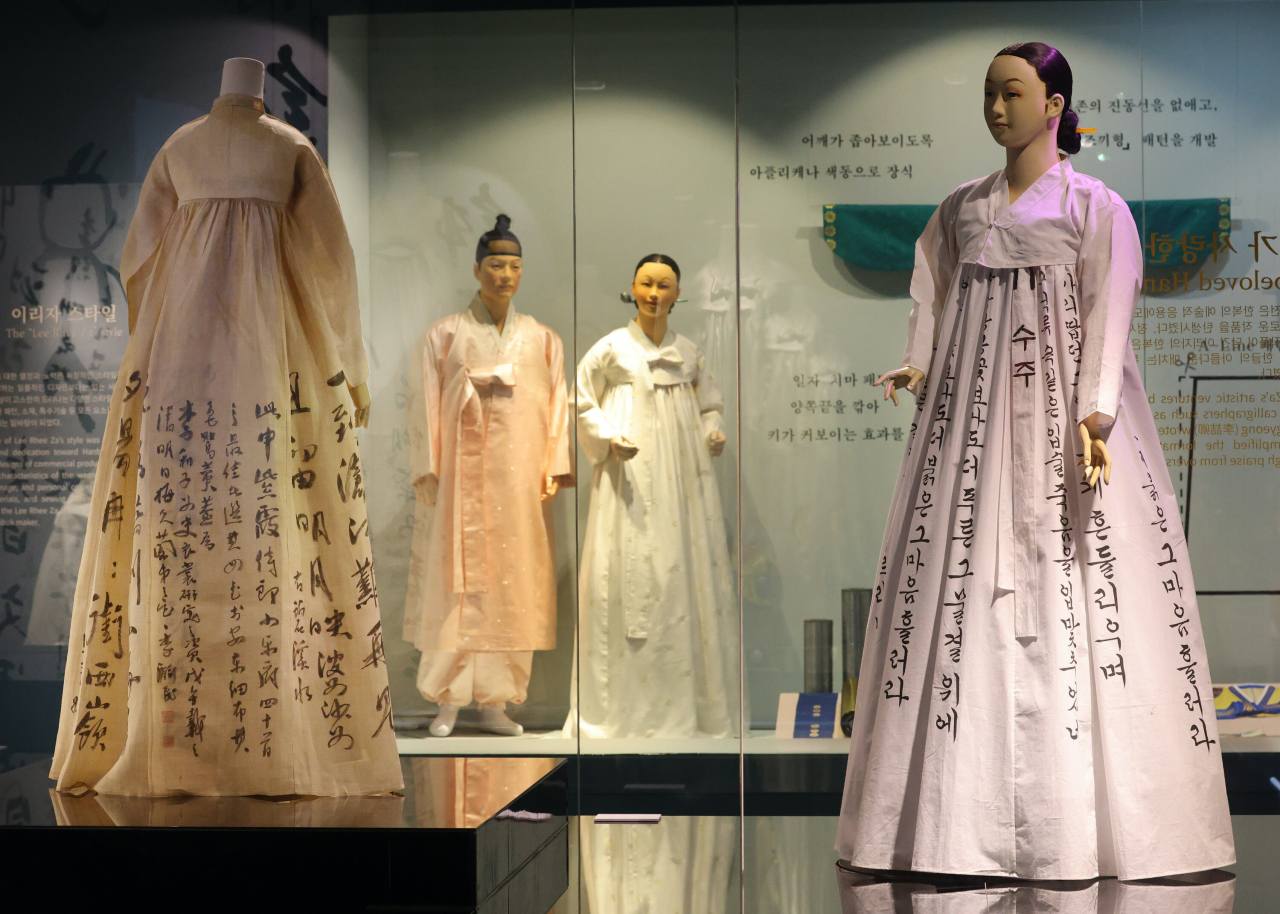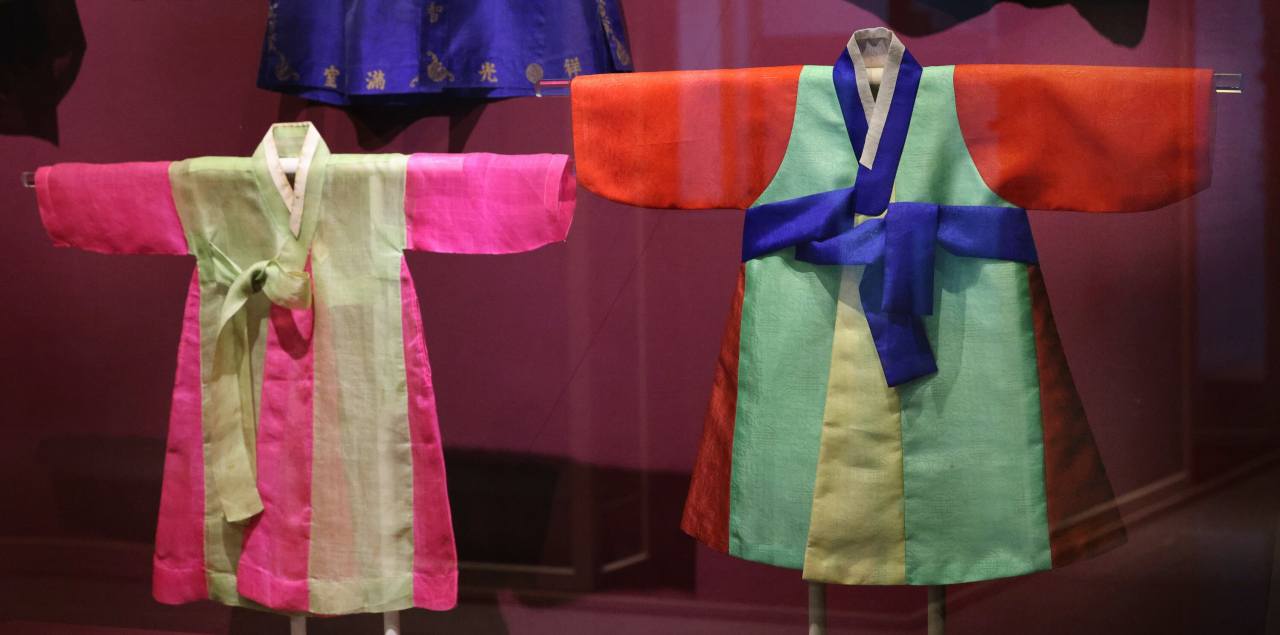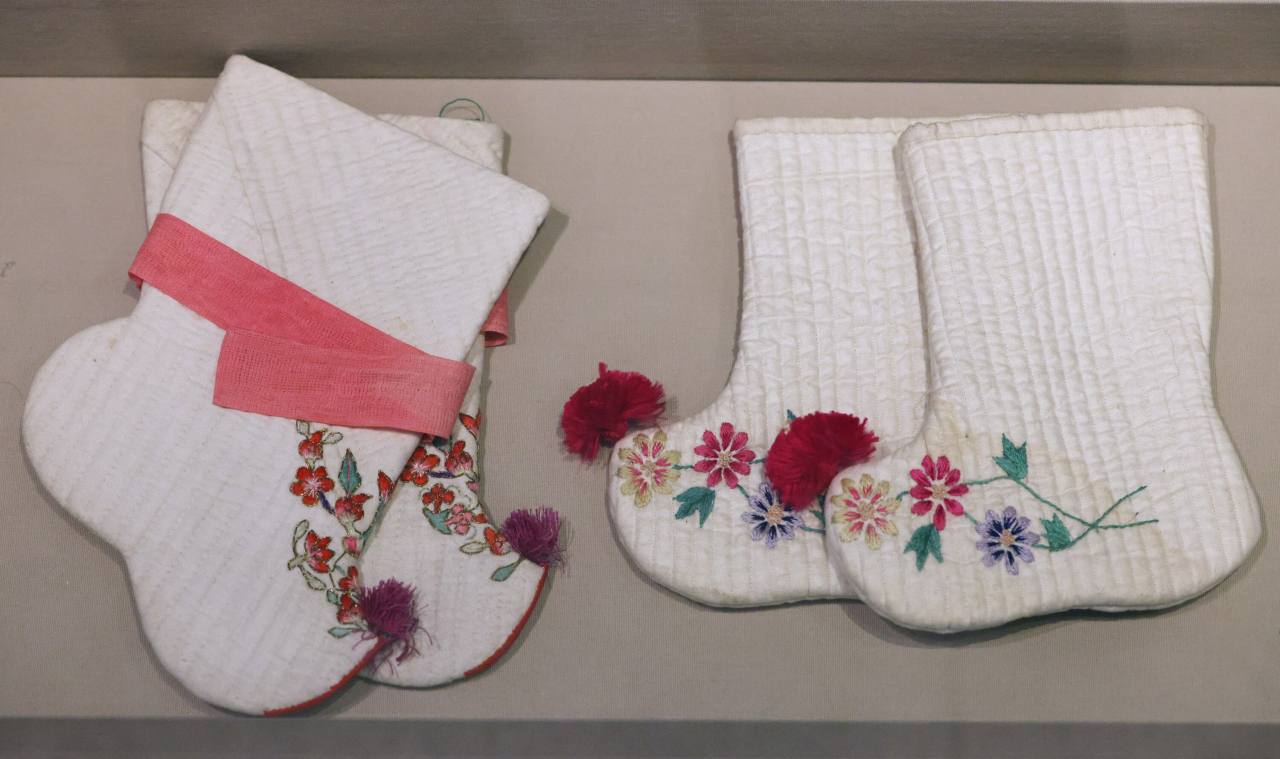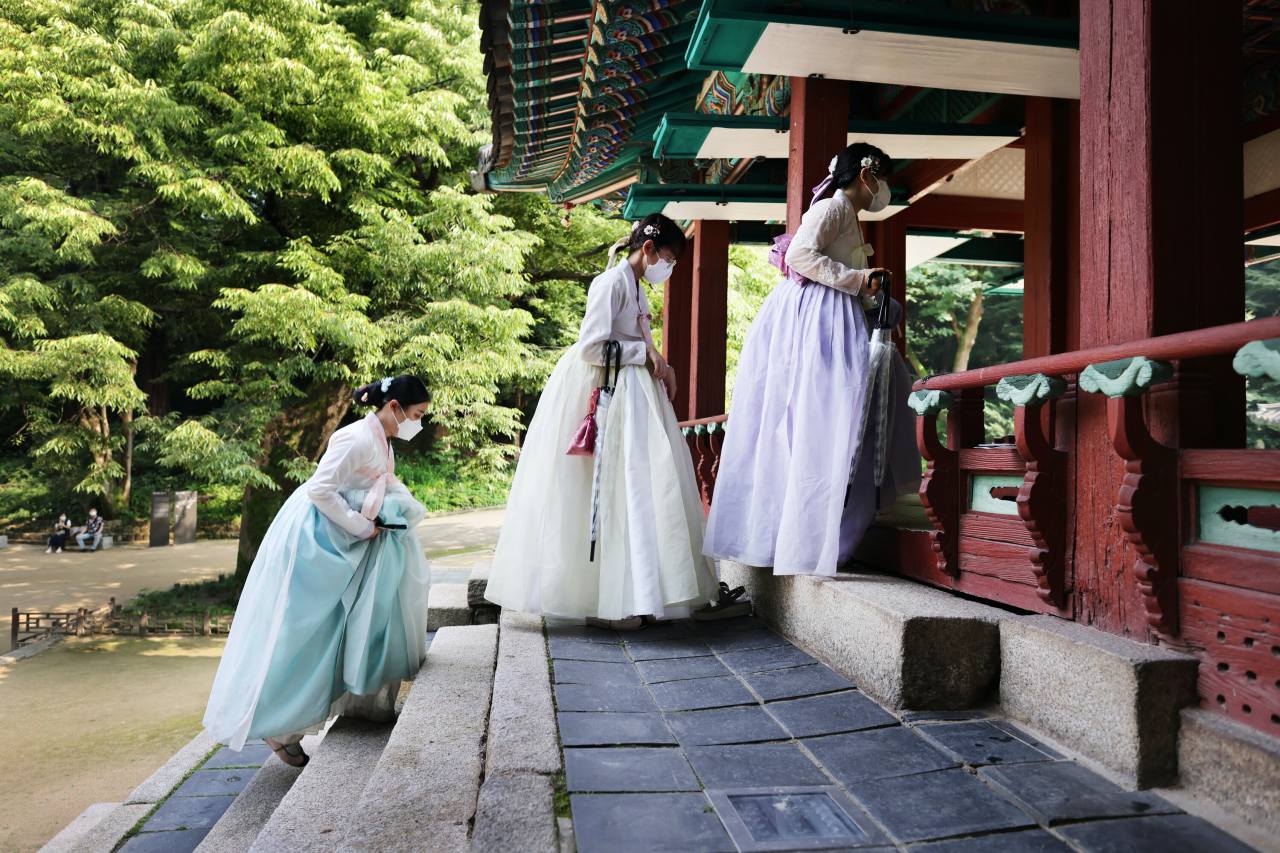 |
Hanbok with Hangeul (right) and Hanja (left) calligraphy by hanbok designer Lee Rhee Za are on display at the Seok Ju-seon Memorial Museum at Dankook University in Yongin, Gyeonggi Province.Photo © Hyungwon Kang |
Clothing is an extension of our self-image. It helps define who we are.
Five colors of nature -- blue, white, red, black, and yellow -- are found in traditional Korean hanbok, including wedding garments.
The colors in children’s clothes bring balance with nature: blue for spring, white for fall, red for summer, black for winter and various shades of yellow representing the land.
“In history books, Koreans were said to have clean clothes, to wear silk clothes and to revere white clothes. In the Goguryeo murals and the drawings of the Goguryeo, Baekje, and Silla envoys visiting the southern Yang Dynasty in China in the sixth century, Koreans definitely look sophisticated compared to diplomats from many other kingdoms,” according to Yi Ki-hoon, who studied the Chinese-Korean historical relationship at the Beijing Language and Culture University in China.
 |
Children’s hanbok with the five colors of nature -- blue, white, red, black and yellow -- are on display at the Seok Ju-seon Memorial Museum at Dankook University in Yongin, Gyeonggi Province.Photo © Hyungwon Kang |
Hanbok have evolved into various styles throughout history. They derive from an ancient Korean garment design prototype, with the left flap of the upper garment always going over the right side of the flap. This feature remains to this date.
Today, most Koreans wear hanbok only on special occasions such as weddings, traditional holidays and memorial anniversaries for ancestors.
Specialists and performers in traditional Korean art and music also wear hanbok on stage.
“Until about 10 years ago, gisaeng, who wore hanbok daily, were my primary customers,” recalls Kim Young-hee, 72, a hanbok maker who now makes hanbok for members of the National Folk Music Center. Kim has been making hanbok for 43 years.
Gisaeng were women who were trained to provide artistic entertainment, serve meals and converse with men at upscale restaurants.
“The hanbok had several fashion changes for the gisaeng market. The length of the jeogori, the upper garment, changed constantly according to the trend,” said Kim.
During the Joseon era, the royal court was the epitome of fashion. Some 3,000 people lived and worked in a Joseon palace. What people wore showed their roles and identities.
A department called Sanguiwon made hanbok for the royal family.
Joseon-era burial chambers preserved a large number of hanbok.
A 16th-century skirt from the graves of two wives from a yangban (ruling class) family, discovered at a construction site in Osan, Gyeonggi Province, in May 2010, looks remarkably fashionable even today.
Several sets of garments were buried with the deceased wives next to their husband. These survived centuries underground along with mummified remains of the two women. It was not uncommon for a yangban man to have multiple wives during the Joseon era.
 |
Two sets of children’s socks called taraebeoseon, worn on a baby’s first birthday, are on display at the Seok Ju-seon Memorial Museum at Dankook University in Yongin, Gyeonggi Province.Photo © Hyungwon Kang |
Korean fashion trends are nothing new in East Asia.
“Before the COVID-19 pandemic, Seoul’s Dongdaemun clothing market was overflowing with Chinese merchants who fed China’s online outlets. On Chinese social media, you can see a lot of interest in young Korean fashion trends,” said Yi, who is currently teaching Mandarin at the Myung-Duk Foreign Language High School in Seoul.
The decline of wearing hanbok began with the introduction of Western garments in the late 19th century, when Emperor Gojong ordered his ministers to wear Western suits when entering the palace.
During the Japanese occupation, the colonial government had policies that discouraged Koreans from wearing hanbok with no less than five government directives.
Hanbok designer Lee Rhee Za (1935-2020) had a significant impact on hanbok trends in the 20th century.
Korea’s first first lady, Francesca Donner Rhee, had her hanbok made by Lee Rhee Za. Rhee was buried in the purple hanbok that Lee made for her.
Lee introduced “marketable” hanbok designs that have won many awards and set the standard for today’s hanbok.
 |
From left: Lee Ui-young, Song Ju-young and Kim Soo-jin walk up the steps to a pavilion at Changdeokgung in Seoul.Photo © Hyungwon Kang |
The beauty of hanbok is that it is so versatile. “You can custom make it to your liking. The jeogori lengths can vary depending on preferences. The sleeve ends can have whatever color finish either matching or mismatching (the color of the dress),” said hanbok maker Kim.
“During the Goryeo Kingdom, sophisticated Goryeo fashion and food trends, called Goryeoyang, dominated Yuan China’s capital, much like how Korean-style fashion trends are leading the Chinese fashion trend today,“ said Yi, who has studied foreign cultural exchange in ancient China.
While hanbok is no longer worn as everyday attire, Seoul’s royal palaces waive entrance fees for visitors wearing a full set of hanbok, which is quite popular among the younger generations who rent traditional clothes and get their pictures taken at the palaces.
By Hyungwon Kang (hyungwonkang@gmail.com)
---
Korean American photojournalist and columnist Hyungwon Kang is currently documenting Korean history and culture in images and words for future generations. -- Ed.
By Korea Herald (
khnews@heraldcorp.com)








![[Herald Interview] 'Trump will use tariffs as first line of defense for American manufacturing'](http://res.heraldm.com/phpwas/restmb_idxmake.php?idx=644&simg=/content/image/2024/11/26/20241126050017_0.jpg)

![[Exclusive] Hyundai Mobis eyes closer ties with BYD](http://res.heraldm.com/phpwas/restmb_idxmake.php?idx=644&simg=/content/image/2024/11/25/20241125050044_0.jpg)
![[Herald Review] 'Gangnam B-Side' combines social realism with masterful suspense, performance](http://res.heraldm.com/phpwas/restmb_idxmake.php?idx=644&simg=/content/image/2024/11/25/20241125050072_0.jpg)